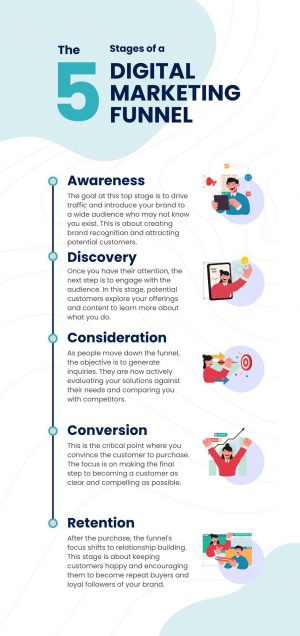
Understanding the B2B Digital Marketing Funnel
A Complete How-To Guide for UK SMEs
For B2B SMEs in the UK, a structured digital marketing funnel is your engine for growth. It delivers qualified traffic, nurtures prospects, and converts them into loyal customers. This guide outlines each funnel stage, how to optimise it, and real-world examples to inspire your strategy.
What is the B2B Digital Marketing Funnel?
A Digital Marketing Funnel maps the journey prospects take—from discovering your brand to becoming a customer, and ultimately, an advocate. In B2B, this funnel is longer, more stakeholder-driven, and relies heavily on content and education. Each stage aligns with specific content types, KPIs, and platforms.
Funnel Stages Overview:
- Discovery/Awareness (Top of Funnel or “ToFu”)
- Interest
- Appraisal/Evaluation (Middle of Funnel or “MoFu”)
- Decision/Action (Bottom of Funnel or “BoFu”)
- Retention/Post-purchase
1. Discovery: Get Found
Why It Matters: This is your first opportunity to make an impression. If your target audience can’t find you, they’ll find your competitors. Building awareness also helps position your brand as a go-to expert.
Goal: Attract new visitors.
Online Locations:
- Google Search (via SEO)
- Web and Social Ads
- UK business directories
- AI Search (LLMs such as ChatGPT)
KPIs:
- New unique visitors
- Search rankings
- Ad impressions/clicks
How to Action It:
- Use SEO tools (like SEMrush or Ahrefs) to identify high-volume UK-specific keywords.
- Write blog posts addressing key pain points or questions your target audience is Googling.
- Launch paid social media campaigns on platforms like LinkedIn, using UK SME targeting.
- List your business in trusted UK directories (e.g. Yell, 118).
- Optimise for AI Search (known as GEO or LLMO)
2. Interest: Educate and Engage
Why It Matters: Once potential customers have discovered you, they want to know if you’re relevant to their specific needs. Useful, engaging content keeps them on your site longer and builds your credibility.
Goal: Nurture initial interest with relevant content.
Online Locations:
- Blog posts
- Informational landing pages
KPIs:
- Page views
- Time on site
- Scroll depth
How to Action It:
- Build a content calendar aligned with industry trends and challenges facing UK SMEs.
- Develop educational landing pages targeted to verticals (e.g. “Digital Marketing for UK Law Firms”).
- Incorporate visuals, explainer videos, and downloadable checklists.
- Use Google Analytics to see what content holds user attention the longest.
3. Appraisal: Build Trust
Why It Matters: B2B decisions involve risk and scrutiny. Prospects will compare you to competitors, read reviews, and validate your claims. At this stage, trust is everything.
Goal: Prove you’re the best choice.
Online Locations:
- Review platforms
- Competitor comparison pages
- 3rd-party rankings
KPIs:
- Backlinks
- Referral traffic
- Domain authority
How to Action It:
- Collect and publish client testimonials from well-known UK businesses.
- Create transparent comparison pages that highlight your strengths.
- List your business on Trustpilot, Reviews.io or similar trusted reviews website.
- Use Digital PR for citation building across the web
- Partner with UK trade associations or media outlets for third-party endorsements.
4. Confirmation: Motivate Action
Why It Matters: Prospects may be on the fence. They need clear, reassuring signals that you deliver what you promise. Strong calls to action and supporting evidence can tip the decision in your favour.
Goal: Help decision-makers commit.
Online Locations:
- Case studies
- Bottom-of-funnel landing pages
KPIs:
- Repeat visitors
- Form completions
- Resource downloads
How to Action It:
- Develop downloadable resources with real results (e.g. “How We Helped a UK Tech Firm Cut CAC by 40%”).
- Use retargeting ads to bring back users who visited pricing or demo pages.
- Run A/B tests on CTAs and form designs to reduce friction.
- Offer short, guided demo bookings or calendar integrations for convenience.
5. Conversion: Close the Deal
Why It Matters: Everything leads to this. A poor contact or checkout process can lose hot leads. Optimising the conversion process ensures that interest becomes revenue.
Goal: Capture leads or sales.
Online Locations:
- Checkout pages
- Contact forms
- Book-a-demo tools
KPIs:
- Conversions
- Cost per lead
- Revenue per visit
How to Action It:
- Keep forms short and clear – ask only what’s necessary.
- Highlight social proof next to conversion points (logos, quotes, certifications).
- Use urgency cues (“Limited UK launch slots available”).
- Follow up instantly with automated thank-you pages or confirmation emails.
Real World Examples of the Digital Marketing Funnel in B2B Business
- Cisco’s Guided Resources – Excellent ToFu content for common IT needs, funnelling into product discovery.
- Ubisoft used A/B testing to increase its lead generation by 12% – Increased engagement via heatmap testing and CRO improvements.
- Directive Consulting’s Landing Page Roundup – UK-relevant examples for trust-building assets.
- Campaign Monitor Dynamic Copy Test – +31% conversion from tailoring headlines to search queries.
- HubSpot Social Trends Report – Smart use of gated content and lead scoring.
KPI Summary Table
| Stage | Goal | Online Location | Key KPI |
|---|---|---|---|
| Discovery | Get Found | Google, Social Ads | Search Rankings, Visitors |
| Interest | Engage | Blogs, Landing Pages | Time on Site, Views |
| Appraisal | Build Trust | Review Platforms | Backlinks, Rankings |
| Confirmation | Re-engage & Motivate | BoFu Landing Pages | Repeat Visits, Clickthroughs |
Practical Steps to use the Digital Marketing Funnel for Your B2B Business
Map your current content to each of the funnel stages
- List All Existing Content
Gather all content assets into a spreadsheet. Include:
- URL
- Title
- Content type (e.g. blog, case study, landing page)
- Publish date
- Performance metrics (page views, bounce rate, conversion rate)
- Tag Each Content Asset
Assign a funnel stage to each content item based on:
- Topic focus (e.g. general insight vs. product specifics)
- CTA (e.g. “read more” vs. “get a demo”)
- User behaviour metrics (e.g. scroll depth, conversion events)
Tip: If content covers multiple stages, duplicate the entry and tag accordingly.
- Identify Gaps & Overlaps
Use a pivot table or simple count:
- Too much content in one stage? (Common in Discovery)
- Too little in BoFu stages? (a conversion leak risk)
- Missing vertical-specific or location-specific content?
- Create a Funnel Content Dashboard
Structure your findings with filters for:
- Funnel stage
- Industry focus
- Geographic focus (e.g. UK-specific)
Track KPIs for each group:
- Awareness: organic traffic
- Interest: engagement time
- Appraisal: bounce rate vs. CTA clicks
- Confirmation: repeat sessions
- Conversion: form completions, demo bookings
Tools to Use
- Screaming Frog / Sitebulb – crawl and export content metadata
- Google Analytics 4 – behaviour and conversion tracking
- SEMrush / Ahrefs – keyword and ranking insight
- Microsoft Excel / Google Sheets – database organisation
Identify gaps for your UK B2B audience
- Define Your UK Buyer Personas
Start by segmenting your UK audience:
- Company size (e.g. micro, SME, mid-market)
- Sector (e.g. manufacturing, legal, tech)
- Job roles (e.g. operations, IT, marketing directors)
- Pain points (e.g. “compliance for UK-based firms”)
Output: Clear persona profiles with industry and region-specific challenges.
- Audit Existing Content by Persona and Funnel Stage
Use your previously mapped funnel content audit to check:
- Which personas are underrepresented?
- Which funnel stages lack depth for UK readers?
- Do you have UK case studies? Local stats? Regional trust factors?
Output: A matrix showing coverage gaps by audience and funnel phase.
- Perform UK-Specific Keyword Research
Use tools like Ahrefs, SEMrush, or Google Keyword Planner, set to UK-only data:
- Search industry-specific problems (e.g. “B2B logistics software UK”)
- Look for long-tail phrases with clear local intent (e.g. “best CRM for UK manufacturers”)
- Compare keyword gaps between your site and UK competitors
Output: List of high-volume, low-competition UK keywords you’re not targeting.
- Analyse Competitor Content in the UK
Look at the top UK competitors’ websites:
- What topics do they cover that you don’t?
- Are they using UK case studies, pricing, spelling, or compliance examples?
- Use Screaming Frog or SimilarWeb to analyse top content pages
Output: Content and topic gap report with direct comparisons to local rivals.
- Interview UK Clients or Sales Teams
Ask your UK sales or customer support team:
- What objections do UK leads raise?
- What questions delay conversion?
- Are there location-specific concerns (e.g. Brexit implications, VAT, GDPR)?
Output: Real buyer questions you can turn into FAQ articles, blog posts, and gated content.
- Review Google Search Console (GSC) Data – UK Only
Filter GSC by UK audience:
- Which queries are bringing UK traffic?
- What are the top exit pages for UK users?
- Are there location-based impressions with low clickthrough?
Output: Missed opportunity insights for optimisation or new content creation.
Content Gap Types to Watch For
Gap Type | Example |
Geo Gap | No UK-specific landing page for a global solution |
Industry Gap | Missing manufacturing/legal/professional services case studies |
Stage Gap | Lacking BoFu UK content (demos, pricing, calculators) |
Keyword Gap | Not ranking for “[industry] software UK” terms |
Trust Gap | No UK-based testimonials, compliance details, or awards |
Create new assets with SEO and GEO targeting
- Set Content Goals per Funnel Stage
Match new assets to gaps in your funnel:
- ToFu: UK keyword guides, awareness blog posts
- MoFu: UK industry-specific whitepapers, webinars
- BoFu: Localised case studies, demo landing pages
Output: Content plan segmented by funnel stage and UK business type.
- Conduct UK-Specific Keyword Research
Use tools like Ahrefs, SEMrush, or Google Trends (UK):
- Focus on buyer intent: “best [product] for SMEs UK”
- Include geo-modifiers: “CRM software UK”, “legal tech for UK firms”
- Cluster by search intent (informational, navigational, transactional)
Output: Keyword map aligned with funnel stages.
- Develop a UK Content Style Guide
Ensure every asset meets UK expectations:
- Spelling: British English (e.g. optimise, organisation)
- Tone: Professional but personable
- Context: Use UK case studies, regulations, stats (ONS, GOV.UK)
- Compliance: GDPR, UK VAT, data hosting standards
Output: Guidelines to maintain consistency across writers and formats.
- Create UK-Optimised Content Assets
Examples by format:
Content Type | UK SEO/GEO Targeting Example |
Blog Post | “How UK SMEs Can Optimise Their Sales Funnel in 2025” |
Case Study | “How We Helped a Yorkshire Manufacturer Reduce Lead Costs” |
Landing Page | “Digital Marketing Services for UK Law Firms” |
Guide/Whitepaper | “The B2B Marketing Blueprint for UK SMEs” |
Use tools like Surfer SEO or Frase to optimise headings, content length, and keyword usage.
Output: Fully optimised, funnel-specific UK content.
- Use On-Page & Technical GEO Signals
Apply UK targeting at page level:
- Meta titles and descriptions: include “UK” where relevant
- H1/H2 tags with UK modifiers
- Embed UK customer logos, testimonials, Trustpilot/ISO badges
- Add local business schema (via JSON-LD)
- Use UK host servers (for faster local performance)
Output: SEO-ready pages with clear geo relevance for UK Google SERPs.
- Promote and Link Strategically
- Earn backlinks from UK directories, publications, and chambers of commerce
- Share on UK-specific LinkedIn groups or SME forums
- Include internal links to BoFu pages or service offerings
- Use Digital PR to promote your brand on other reputable online publications
Output: High-authority links and qualified traffic from local B2B audiences.
Tools to Help
- Surfer SEO – for UK search intent alignment
- Screaming Frog – crawl your geo tags, H1s, internal links
- Yoast SEO / RankMath – optimise WordPress SEO with geo modifiers
- BrightLocal – local SEO audit and UK directory builder
Track KPIs per stage
- Define Key KPIs by Funnel Stage
Funnel Stage | Primary KPIs | Purpose |
Discovery | New users, impressions, ranking positions | Measure visibility & reach |
Interest | Time on page, bounce rate, scroll depth | Gauge engagement quality |
Appraisal | Referral traffic, backlinks, review volume | Assess trust-building performance |
Confirmation | Return visits, resource downloads, CTA clicks | Identify re-engagement & intent |
Conversion | Form completions, demo bookings, revenue per visit | Measure lead capture & deal flow |
Output: Defined KPI framework aligned to funnel strategy.
2. Set Up Tracking Tools
Use these core tools:
Tool | Funnel Application |
Google Analytics 4 | Track user behaviour across funnel |
Google Search Console (UK filtered) | Monitor UK keyword rankings |
Visual scroll/click tracking | |
CRM (HubSpot, Salesforce) | Attribute leads to funnel content |
CallRail / WhatConverts | Track lead sources across contact forms |
Output: Tech stack ready to attribute content to funnel outcomes.
3. Build Funnel-Based Dashboards
Segment reports by funnel stage:
- ToFu Dashboard: Organic sessions, top landing pages (UK traffic), keyword positions
- MoFu Dashboard: Content engagement metrics, lead magnet downloads
- BoFu Dashboard: Repeat visitors, form engagement, exit intent
- Conversion Dashboard: CPL, conversion rate, revenue/lead
Use Looker Studio (formerly Google Data Studio) to visualise live funnel KPIs, filtered by UK traffic sources.
Output: Dashboards you can review weekly or monthly.
4. Set Baselines and Benchmarks
For each stage:
- Establish historical baselines (last 3–6 months)
- Compare performance to UK competitors using SimilarWeb, SEMrush, or Ahrefs
- Set UK-specific targets based on B2B benchmarks (e.g. 2–5% conversion rate)
Output: Clear performance targets with measurable improvements.
5. Monitor & Optimise in Cycles
Use monthly reporting cycles:
- Highlight which funnel stages underperform
- Identify bottlenecks (e.g. strong ToFu but weak BoFu)
- Prioritise updates to content, CTAs, and UX based on insights
Output: Continuous performance improvement across the full funnel.
Test, optimise, scale
- Set Up Controlled Testing at Each Funnel Stage
Break tests down by funnel phase to isolate performance variables:
Funnel Stage | What to Test | Tools |
Discovery | Blog titles, meta descriptions, featured snippets | Google Search Console, A/B SEO tools |
Interest | Page layout, media formats, CTA placements | Hotjar, Microsoft Clarity |
Appraisal | Social proof layout, review widgets, testimonial depth | Trustpilot, Reviews.io |
Confirmation | Retargeting message, asset formats (PDF vs video), CTA copy | Meta Ads, LinkedIn Ads |
Conversion | Form length, CTA wording, pricing structure | Google Optimize, VWO |
Output: Prioritised test matrix across funnel stages.
- Apply the A/B and Multivariate Testing Process
Use this cycle:
- Formulate Hypothesis – e.g. “Adding UK-specific case studies will increase demo conversions by 15%.”
- Split Audience – Segment UK traffic, role, or funnel stage
- Run the Test – Over a statistically significant sample size (minimum 2 weeks)
- Measure Impact – Use pre-defined KPIs per stage
- Apply or Iterate – Keep the winning version, test further refinements
Output: Evidence-based improvements, not guesswork.
- Optimise Based on UK Audience Insights
Focus on:
- UK-specific copy: Adjust tone, terminology, spelling
- Cultural relevance: Avoid US references; highlight UK compliance, partners
- Device & channel behaviour: Many UK SME decision-makers use mobile + LinkedIn
Track micro-metrics:
- CTA click rate
- Scroll depth on long-form pages
- Drop-off in form completions
Output: Higher engagement and lower friction throughout the funnel.
- Scale What Works
Once an asset or tactic performs well:
- Clone and adapt it for other UK industries or regions (e.g. “Digital Marketing for Yorkshire Manufacturers”)
- Boost with paid promotion (LinkedIn Lead Gen Forms, Meta remarketing)
- Expand into new formats – Turn a successful blog into a webinar or guide
- Automate nurture sequences for top-performing MoFu assets (e.g. drip campaigns)
Output: Replicable, scalable content and campaigns for UK SME lead generation.
- Build a Feedback Loop
Create a monthly cycle:
- Review performance dashboards
- Prioritise low-performing stages
- Assign actions to optimise/test
- Update your funnel documentation and persona assumptions
Output: An adaptive, always-improving marketing engine.
Boost Your Business
Ready to transform your UK small business website into a powerful growth engine?
Greyturtle specialises in creative, effective web design and digital marketing solutions.

